-- From Chitina to Cantwell
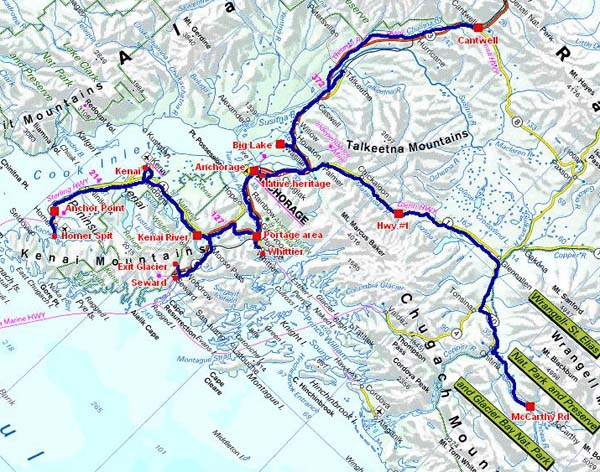
The road tracklog
from Chitina to Cantwell
from 2011/06/20 to 2011/06/26
Actually the waitress of the Hotel Chitina did not know the WiFi connection password! Consequently I did not publish my website what I carried out by passing at Glennallen on the way towards Palmer. On Hwy # 1 weather was degraded, it rained. I stopped on a carpark at the edge of the road.
Palmer
as of daybreak I passed at the foot of Matanuska Glacier, one says that it is the most dramatic in Alaska. At its terminal it is 4 miles wide.

Toe of Matanuska Glacier
Hwy #1
20/06/2011
I stopped at the Visitor Center-Museum in Palmer which exhibits items of the end of the 19th century and especially the story of the settlement of Palmer at the moment of the economic crisis of 1930 by showing many pictures of this era. It is one of the characteristics of the American people which do not hesitate to move over thousands kilometers to find a job at the price of many sufferings. It is worth the detour.
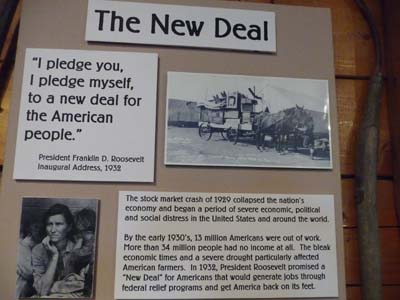
Crash of 1929
Palmer Museum
20/06/2011

Settlement of the city
Palmer Museum
20/06/2011
Kenai Peninsula
Volcanoes and earthquakes happen in the so-called "Ring of Fire", an unstable
tectonic zone surrounding the Pacific Ocean from New Zealand to Siberia and
from Alaska to South America.
Alaska has more than 130 volcanoes of which more than 50 were active within
Captain Cook's visit. They are located along the Aleutian Arc and
Cook Inlet up to Anchorage: MT Spurr, MT Doubt –last eruption on April
2009 - MT Iliamna and Augustine Volcano –last eruption on January 2006-
The Kenai Peninsula is surrounded in the west by Cook Inlet and in the east by
Gulf of Alaska. The oil slick of Exxon Valdez extended from the bay of Valdez
up to Cook Inlet surrounding all the Kenai peninsula.

Pratt Museum, Homer
24/06/2011
Anchorage
Around 70 km further away Anchorage the megalopolis in Alaska, 300,000 inhabitants. The city is very large but the downtown was designed with streets at right angle, be careful with one way street! I spent the afternoon at the Anchorage Museum, superb. Each First Nation is presented with synoptic of its origin, its prehistoric artifacts and its current situation. Of course the purchase of Alaska from Russia is exposed.
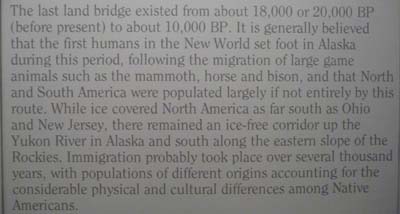
At the beginning
Anchorage Museum
20/06/2011

First Nation
Palmer Museum
20/06/2011

Mask
Anchorage Museum
20/06/2011
Then the development of the land under the aegis of the USA is presented by topic, gold rush, railroad, first telegraph line and an episode of the Pacific War in the Aleutian Islands which I did not know.

Pacific War
Palmer Museum
20/06/2011
Finally modern times are shown with the construction of Trans-Alaska Pipeline. At the end of the afternoon I failed Creekwood RV Park, out of price for the services given.

Trans-Alaska Pipeline
Anchorage Museum
20/06/2011

Trans-Alaska Pipeline
Palmer Museum
20/06/2011
Alaska Native Heritage Center is in the north of Anchorage on Hwy # 1, its purpose is to present the First Nations of settlement in Alaska which are divided into 11 distinct cultures speaking 21 different languages. Four areas expose this goal, storytelling, dance and music of these people, an exhibit gives to see items past and present, artist studios offer their creations to the visitors and in outdoor habitats are reconstituted explaining the life of the people. I strolled the morning in this magic place.

Alaska Native Heritage Center
Anchorage
21/06/2011

Alaska Native Heritage Center
Anchorage
21/06/2011

Alaska Native Heritage Center
Anchorage
21/06/2011
Whittier
Then I moved southwards to visit the village of Whittier created by the American army during the WWII to fight Japanese having invaded the Aleutian Islands. To disenclose this secret port a single-lane 2.6 mile-long railway tunnel was dug. I crossed it. The museum of the city introduces protagonists of two bloody battles in the islands at Attu and Kiska in ten display cabinets. Then during the cold war the army built Buckner Building gathering the secret services, today in the state of ruin. The day began in fog with a oceanic drizzle to finish in heat sun at Whittier.

Anton Anderson Memorial Tunnel
Whittier
21/06/2011

Anton Anderson Memorial Tunnel
Whittier
21/06/2011

The battle of Attu
Whittier Museum
21/06/2011
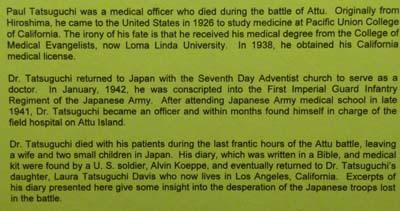
The battle of Attu
Whittier Museum
21/06/2011

The battle of Kiska
Whittier Museum
21/06/2011

Buckner Building
Whittier
21/06/2011
The second city visited in the Kenai peninsula was Seward after the name of the American Secretary of State who negotiated the purchase of Alaska from the Russian government. Initially before entering the city I made a detour of about 8 miles to admire the Exit Glacier, evacuation of ice from the Harding's ice field. It was a walk of one hour in the middle of morning before the sun hide behind clouds.
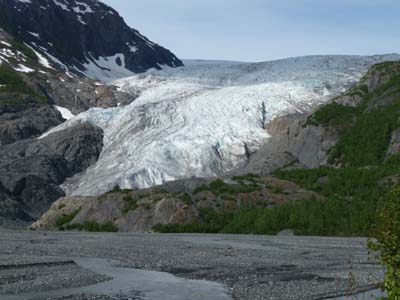
From view point
Exit Glacier
22/06/2011

From its edge
Exit Glacier
22/06/2011
Birth of a Town
Seward
Seward does not have anything extraordinary if it is not the small museum at the honor of the founders of the city and some others notables. It looks like a shop of the flea market in St Ouen, suburb of Paris. I do not resist to tell its birth with some pictures of the era put in prospect with those of today. I discovered in a recess the significance of the Alaska's Fag. At the end afternoon I took again the road to bivouac at the edge of Hwy # 1.

Ballaine
Seward
22/06/2011

Why ?
Seward
22/06/2011
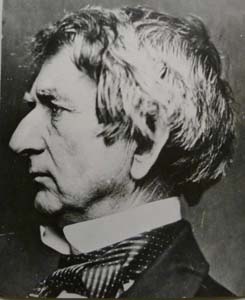
William H.
Seward
Seward
22/06/2011

Cartoon, William H. Seward
Seward
22/06/2011

1903
Seward
22/06/2011
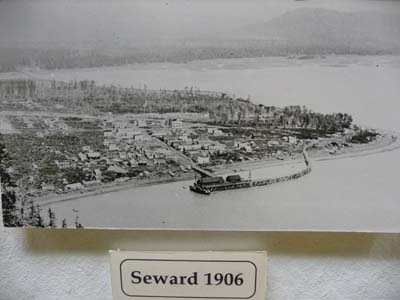
1906
Seward
22/06/2011

1906
Seward
22/06/2011

2011
Seward
22/06/2011
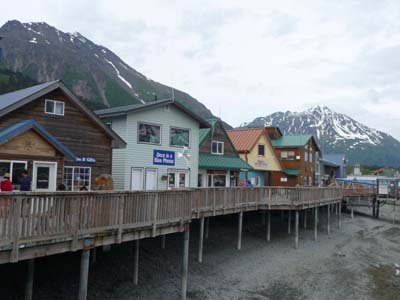
2011
Seward
22/06/2011
Alaska's Flag

Museum
Seward
22/06/2011
Cooper Landing
Thursday June 23 by a beautiful sunny day I visited four villages on the way towards Homer at the end of the Kenai peninsula. Shortly after my bivouac I reached Cooper Landing, Mecca of fishermen in Alaska. In this season cars, motor homes were parked along Kenai River and of Skilak Lake. As of 8 am fishermen were in the frozen water frozen up to the belt fishing-rod in hand to catch either a salmon or a trout.

Fishing Tackle
Cooper Landing
23/06/2011
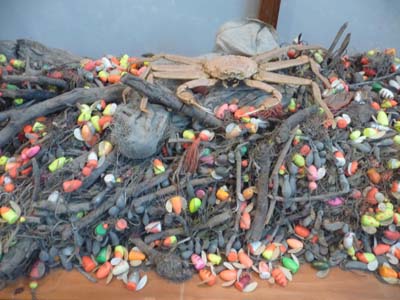
Fishing tackle
Cooper Landing
23/06/2011
Kenai
Kenai, a village creates by Russian settlers, has a Visitor Center-Museum which is worth neither the detour nor the moderate fee. Behind, the old Russian city shows some old buildings and the Orthodox Church with a priest who was my guide detailing the icons one by one.
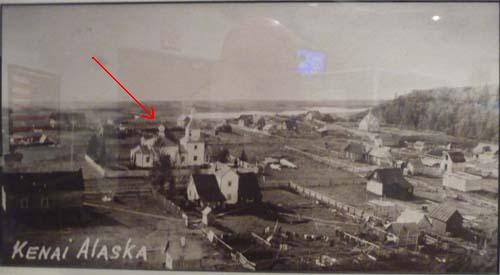
1919
Kenai
23/06/2011
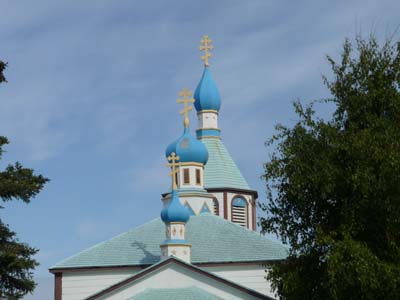
Russian Orthodox Church
Kenai
23/06/2011

Russian Orthodox Icon
Kenai
23/06/2011
Soldotna
Soldotna was established in 1946 to give homesteads the veterans of the WWII. The beneficiaries ran up against extreme climatic conditions and the lack of road and hospital infrastructure. Homestead Museum gathers some log houses of this time.

Russian Orthodox Church
Kenai
23/06/2011
Nikiski
Nikiski is another Russian village dating back to 1791 with a church on the hill overhanging the village at the seashore. I stopped after Anchor Point.
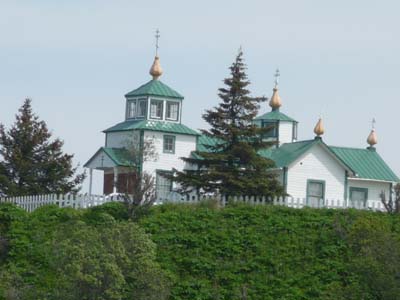
Russian Orthodox Church
Nikiski
23/06/2011

Village
Nikiski
23/06/2011
Homer
In the various collected booklets I had read all the praises of the city considered as land's end of Kenai Peninsula. Actually and especially in this season it is dedicated to fishing on sea and more particularly to the Derby of Halibut. The first city was built at the end of Split, 5-mile long sand land. Today they are only shops offering of the fishing years or tourist traps tourists.

Homer
24/06/2011

Landmark
Homer
24/06/2011
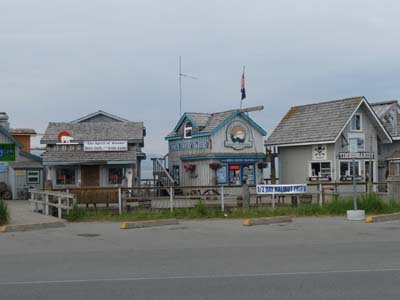
Shops on Homer Spit
Homer
24/06/2011
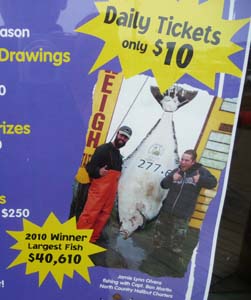
Largest Halibut: 277,6 lb
Homer
24/06/2011
Pratt Museum is identical to the preceding already visited museums but it exhibits new picture of the ecological tragedy by Exxon Valdez and more particularly a picture of her captain. I left the site in the fog in the afternoon after having lunch a King Crab which will not leave me an imperishable memory.
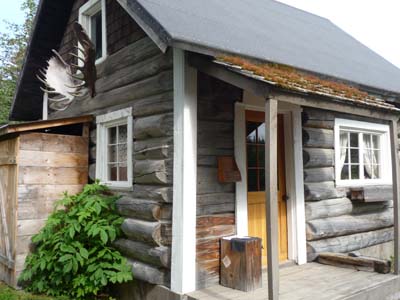
Harrington Cabin
Homer
24/06/2011

Lynx
Homer
24/06/2011

Lynx
Homer
24/06/2011
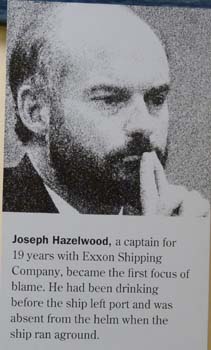
Captain of Exxon Valdez
Homer
24/06/2011
I had reserved the morning of my return in Anchorage to visit the downtown. It had rained all the night and despite everything the sky was still covered by heavy clouds. I strolled in the right-angle streets without discovering the least interest at this typically American city, Shopping Centers with car silo of noisy color, old buildings close to cubes of glass and steel and a church, fortified castle of the faith. At a corner of a street the organizer of a dog race was either of indefinite sex or a clown. Fortunately I discovered the Saturday market with animations and, stands of togs and of puffs out. I left this city without regret by thinking of the museum that I had visited before. I stopped a hundred kilometers further away at the edge of Big Lake.
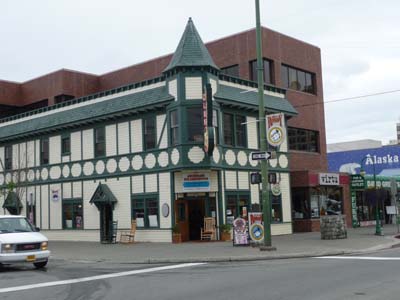
Old & Modern
Anchorage
25/06/2011

Red light district
Anchorage
25/06/2011

Church, castel
Anchorage
25/06/2011

Dog-race emcee, Man or woman ?
Anchorage
25/06/2011

Shopping Centers
Anchorage
25/06/2011

Visitor Center
Anchorage
25/06/2011
Talkeetna
On the way towards Denali Park where I intended to remain two days, I made a detour to visit Talkeetna, the base camp for climbing the Mt McKinley and the airport to make a reconnaissance flight of the highest mountain in the USA 6,194 meters high famous the coldest due to its localization. The village is much tourist in this rainy Sunday. I did not last for ever and carried on my road up to Cantwell where there was a RV campground with a WiFi Internet connection to publish the pages of my website as Sundays.

Welcome
Talkeetna
26/06/2011

Main Road
Talkeetna
26/06/2011